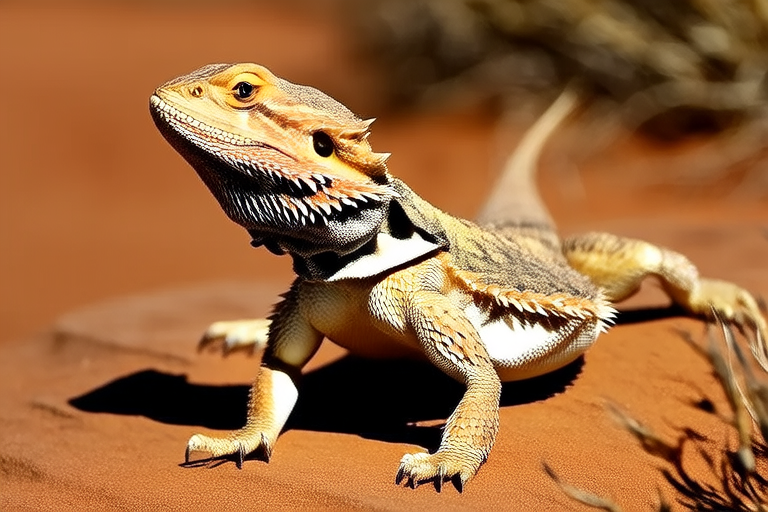Bearded Dragons and Their Fascinating Behavior: A Closer Look
Welcome to a deep dive into the world of bearded dragons, one of the most popular reptilian pets. These captivating creatures have captivated the hearts of many, and for good reason. With their unique appearance, intriguing behaviors, and relatively easy care requirements, bearded dragons make for wonderful companions. Let’s explore the origins, physical traits, dietary habits, social behaviors, and more of these fascinating reptiles.
Origins and Habitats
Native to Australia, bearded dragons inhabit various environments, from arid deserts to semi-arid woodlands. They are well-adapted to hot, dry conditions and can be found basking in the sun or hiding under rocks. The most common species kept as pets is the Inland Bearded Dragon (Pogona vitticeps), which originates from the central desert regions of Australia.
Physical Characteristics
Bearded dragons possess several distinctive features that set them apart from other lizards. One of their most recognizable traits is their ‘beard,’ a pouch of expandable skin located under their chin. This feature can change color, ranging from black to dark grey, when the dragon feels threatened or during mating displays. Other notable features include their spiny scales along their back, which provide protection against predators, and their robust limbs, perfect for climbing and digging.
Diet and Its Impact on Behavior
Bearded dragons are omnivorous, meaning they consume both plant matter and animal protein. In the wild, their diet consists of insects, vegetation, and flowers. As pets, they thrive on a balanced diet of commercial pellets, leafy greens, and occasional feeder insects like crickets or mealworms. Proper nutrition is crucial for maintaining their health and energy levels, which in turn influences their behavior. Well-fed dragons tend to be more active and responsive, while malnourished ones may exhibit lethargic or aggressive behavior.
Social Behaviors
Bearded dragons are generally solitary creatures in the wild but can coexist peacefully in captivity if introduced correctly. Males may become territorial and aggressive towards each other, so it’s advisable to house only one male per enclosure. Females and juveniles can share space more harmoniously. These reptiles display interesting social behaviors, particularly during breeding season, where males perform elaborate courtship dances involving head bobbing and arm waving.
Communication Methods
Bearded dragons communicate through a variety of gestures and postures. Head bobbing is a common form of communication used by males to establish dominance or attract mates. Beard puffing, as mentioned earlier, signals aggression or stress. Arm waving serves multiple purposes, including greeting other dragons and cooling down after basking. Understanding these signals can help owners interpret their pets’ moods and needs effectively.
Sleep Patterns and Environmental Needs
Bearded dragons require a specific environment to thrive. They need a temperature gradient within their enclosure, ranging from 80 to 90 degrees Fahrenheit on the warm side and 70 to 75 degrees Fahrenheit on the cool side. Ultraviolet (UV) lighting is essential for calcium absorption and overall health. Bearded dragons are crepuscular, meaning they are most active during dawn and dusk. They typically sleep at night but may nap during the day as well.
Care Tips for Owners
For those considering adopting a bearded dragon, here are some essential tips:
- Proper Housing: Provide a spacious terrarium with appropriate substrate, hides, and climbing structures.
- Temperature Regulation: Maintain a consistent temperature gradient using heat lamps and under-tank heaters.
- Lighting: Install UVB lighting to ensure proper vitamin D3 synthesis and calcium absorption.
- Dietary Needs: Offer a varied diet rich in vegetables, fruits, and protein sources.
- Hydration: Ensure fresh water is always available and mist the enclosure regularly to maintain humidity.
- Handling: Approach your dragon gently and allow it time to adjust to your presence before attempting to handle it.
Understanding your bearded dragon’s behavior is key to providing optimal care. By familiarizing yourself with their natural tendencies and addressing any signs of distress or discomfort promptly, you can ensure a long, healthy life for your scaly friend.
In conclusion, bearded dragons offer an unparalleled opportunity to connect with these ancient creatures. Their unique behaviors, coupled with their ease of care, make them ideal pets for reptile enthusiasts of all levels. By fostering a deeper understanding of their needs and preferences, we can create enriching environments that promote their well-being and happiness. Whether you’re a seasoned herpetologist or a curious novice, there’s always something new to learn about these fascinating reptiles.
